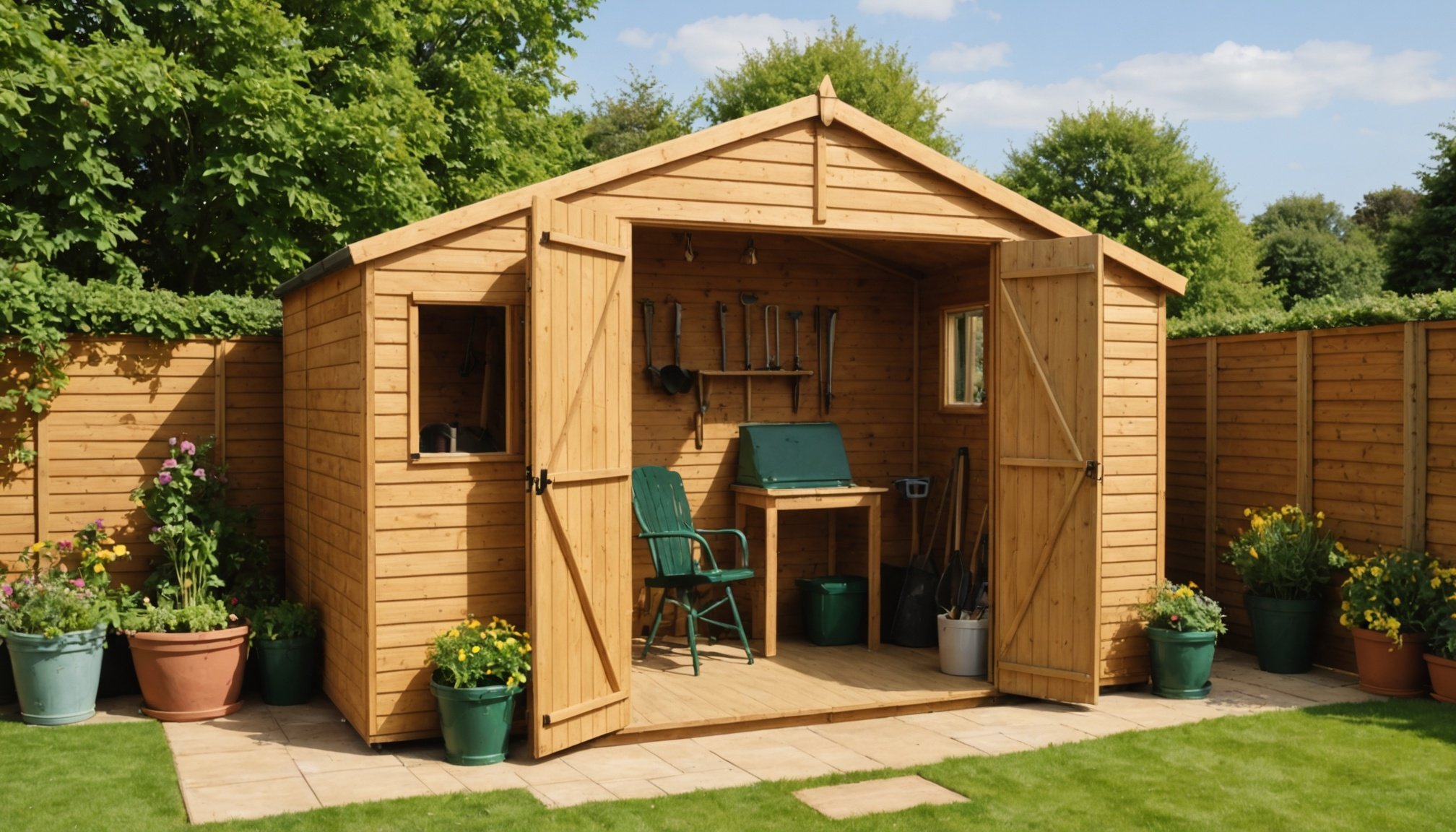Understanding Your Garden Space
When considering the shed placement within your garden space, it’s crucial to assess the available area thoroughly. First, take into account existing structures and the landscape to determine the best spot. The landscaping considerations may include ensuring the shed doesn’t overshadow beautiful plants or block natural light crucial for your shrubs.
Next, consider the impact of location on garden aesthetics. The shed should complement your garden, not clash with its character. A poorly placed shed can become an eyesore amidst your lush greenery. Therefore, aligning its location with your garden’s overall design is vital for maintaining visual harmony.
Additional reading : Ultimate handbook for enhancing uk bungalows: transforming for perfect wheelchair access
Consider accessibility and functionality as well. The shed should be easily accessible without disturbing garden pathways or flower beds. Think about how you’ll use the space daily. Will it be a storage hub or perhaps even a workshop? Its function will influence its placement.
Thus, by carefully evaluating your garden space and balancing practical needs with aesthetic desires, you can ensure the shed enhances your garden rather than detracts from it.
Also to discover : Shop the best jewelry box options for every style and need
Determining Size and Layout
Before deciding on your garden shed’s dimensions, consider its intended use. Answering questions like “Will it house gardening tools, or serve as a workshop?” helps navigate size options with precision. A small tool shed may suffice if you’re storing only essential items, whereas a workshop necessitates larger space.
Focus on garden layout to ensure a harmonious flow. Strategic placement enhances accessibility without disrupting your garden’s natural beauty. Imagine various layout scenarios to visualise how the shed will sync with existing garden elements.
Several factors influence size determination, primarily storage needs. Any seasonal equipment, bikes, or bulky items might warrant a larger structure. Yet, remember, a shed too large may overpower your space, clashing with garden aesthetics.
To optimise spatial resources, avoid a one-size-fits-all approach. Customisation, based on current and future usage, achieves the best results. This thoughtful planning phase guarantees that your new shed complements, rather than competes, with your garden.
Selecting the Right Materials
When choosing a shed, prioritising materials is key. Here’s a breakdown:
-
Wood is a popular choice due to its natural aesthetic appeal and versatility. While durable, it requires regular maintenance, such as treating for pests and rot. Insulation properties offer natural weather resistance, keeping tools safe from the elements, but routine upkeep is vital.
-
Metal sheds provide high durability and are generally low-maintenance. They offer significant weather resistance, often being galvanised to prevent rusting. However, insulation may be less effective, possibly leading to condensation issues inside unless properly ventilated.
-
Plastic sheds are gaining popularity for their resilience to weather conditions and minimal maintenance requirements. Typically made from high-density polyethylene (HDPE), these sheds resist rot and pests. Though less traditional in appearance, they often come with modern designs that can easily blend with existing garden aesthetics.
Evaluating maintenance requirements is essential. Consider your willingness and ability to commit to upkeep when choosing. Each material offers distinct advantages and challenges, shaping not only the shed’s longevity but also its fit with your garden’s needs.
Aesthetic and Design Considerations
Before diving into shed design, reflect on your garden’s overall aesthetic. Your shed should act as a seamless extension of the landscape. Whether your garden leans towards vintage charm or modern minimalism, aligning the shed design with existing styles enhances visual harmony.
Customization presents a wonderful opportunity to add personal touches. Think about incorporating unique features like decorative windows or bespoke detailing that reflect your personality. These creative designs ensure your shed stands out, offering both functionality and charm.
When selecting color palettes and finishes, aim for those complementing your garden’s natural hues and textures. Soft greens and earthy tones tend to merge effortlessly, creating a tranquil environment. In contrast, vibrant colors can act as creative focal points, adding a lively edge to your space.
To truly elevate your shed’s presence, consider its integration within the garden. This approach involves selecting materials and designs that reflect and respect your existing garden features, ensuring the shed becomes a highlight rather than an oversight in your outdoor sanctuary.
Budgeting for Your Shed
Identifying essential cost factors is pivotal when planning your shed purchase. Beyond the initial purchase price, consider expenses like installation and maintenance. If hiring professionals for setup, labour costs must be accounted for. Similarly, some materials demand more upkeep, impacting long-term expenses.
Understanding the balance between initial investment and long-term value is crucial. While a pricier option may strain your budget initially, it might offer enhanced durability and weather resistance, reducing replacement frequency. Evaluate the cost-effectiveness by weighing upfront savings against potential future costs, like repairs or replacements.
Exploring financing options can assist in managing your budget effectively. Consider if stores provide payment plans, allowing you to spread the cost over time rather than paying a lump sum. Additionally, employing cost-saving tips such as purchasing off-season or selecting a DIY approach can further ease financial burdens.
By considering essential costs, assessing long-term value, and exploring different financial avenues, you can ensure your shed investment is both economical and effective. This careful budgeting process empowers you to make informed decisions tailored to your financial situation and garden needs.
Understanding Local Regulations
Navigating local regulations is essential when planning your shed installation. Firstly, ascertain any planning permissions required. Generally, the necessity for such permissions hinges on the shed size and its proximity to property boundaries. Smaller sheds, typically, evade rigorous regulatory oversight compared to larger structures, which might stir community concerns.
Be aware of local guidelines and restrictions that may impact your design and placement options. Every municipality or county might impose different regulations dependent on zoning laws and community aesthetic standards. Delving into these details ensures your shed project doesn’t face unexpected legal setbacks.
Furthermore, consult the local council to understand if your area has building regulations stipulating material use for sheds. In certain regions, sheds must withstand specified weather conditions, thus impacting your choice of materials. This proactive step ensures compliance and can save time and costs related to forced adjustments later.
Remember, understanding and adhering to these local regulations not only guarantees a hassle-free installation but also contributes to maintaining neighbourhood harmony. Addressing these aspects early aligns your shed project seamlessly with its surroundings.
Maintenance and Longevity
Regular shed maintenance is essential for ensuring longevity. Establishing a routine can help preserve both the aesthetic appeal and functionality of your shed, prolonging its lifespan. Start with periodic checks for rot or rust, depending on your shed’s material. Wooden sheds require treatments to prevent pest damage and decay, whereas metal sheds benefit from rust-proof coatings.
Protective measures are another cornerstone of shed longevity. Consider applying a weather-resistant sealant to shield against unpredictable elements. Positioning your shed with sufficient ventilation also reduces internal moisture build-up, preventing deterioration. Regularly clean the roof and drainage systems to avoid debris accumulation that can lead to structural issues.
Recognizing early signs of wear, like peeling paint or warped panels, allows for timely repairs, maintaining the shed’s integrity. When damage surpasses repair capabilities, consider replacing affected components to halt further problems. Addressing such issues promptly saves on larger repair costs later.
In summary, by dedicating attention to upkeep tasks and reacting swiftly to signs of wear, homeowners can effectively prolong the life and enhance the performance of their garden shed, ensuring a lasting addition to their garden space.
Integrating the Shed into Your Garden Oasis
The art of garden integration lies in seamlessly blending your shed into the landscape, creating an aesthetically pleasing and functional environment. Enhancing the oasis effect involves strategically placing plants and features around the shed. This not only beautifies the structure but also makes it a natural extension of your garden. Consider plants with varying heights and textures to frame the shed, contributing to a cohesive garden aesthetic.
Incorporation speaks to not just beauty but also functionality. Utilising the shed as part of your garden experience adds value. For instance, consider connecting garden pathways to the shed’s entrance or even integrating seating nearby, making it a restful retreat. You might also use the shed’s exterior walls to support climbing plants or garden tools, doubling its practical purpose.
Through thoughtful integration, the shed becomes more than just storage, aligning with and enhancing your overall garden design. This ensures that the shed complements both the visual and experiential aspects of your outdoor space while maximising its functional benefits.



